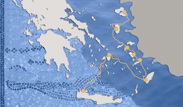The castle of Palaio Pyli
The archives of Patmos provide the
first information about the castle and the medieval village of Old Pyli which
are located in the area modern of Amani, at central Kos.
Specifically, the
edict of Alexios I Komnenos in March 1085, confirms the donation of two site on
the island to Christodoulos Latrinos, founder of the Monastery of St John the
Theologian in Patmos, and their tax exemption. Christodoulos founded the
Monastery of Theotokos, also known as Panagia Kastrianon. In 1088 the area of Pyli accrues to the Byzantine state as part of
the estate of
Christodoulos, and in return the monk was granted the island of Patmos. In 1493
the castle of Old Pyli, an important refuge for the population from the Ottoman
invasions that occurred during the Knights' period, was severely damadged by a
powerful earthquake. One of the events related to the castle occurred in 1526,
during the uprising of the inhabitants against the Ottoman administration, when
Christian locals massacred Muslims and then barricaded the castle. The Castle
was reportedly abandoned after the epidemic of the early 19th century.
in March 1085, confirms the donation of two site on
the island to Christodoulos Latrinos, founder of the Monastery of St John the
Theologian in Patmos, and their tax exemption. Christodoulos founded the
Monastery of Theotokos, also known as Panagia Kastrianon. In 1088 the area of Pyli accrues to the Byzantine state as part of
the estate of
Christodoulos, and in return the monk was granted the island of Patmos. In 1493
the castle of Old Pyli, an important refuge for the population from the Ottoman
invasions that occurred during the Knights' period, was severely damadged by a
powerful earthquake. One of the events related to the castle occurred in 1526,
during the uprising of the inhabitants against the Ottoman administration, when
Christian locals massacred Muslims and then barricaded the castle. The Castle
was reportedly abandoned after the epidemic of the early 19th century.
Traces the Cyclopean walls on the NW side and ceramic finds from the Bronze Age
attest the prehistoric occupation of the site. The medieval fortifications of
the 11th century strengthened and expanded its naturally fortified position
with new enclosures. The first, upper enclosure surrounds the hilltop, while
the second defines a greater area to the east, west and south side of the
first. Traces of walls and a gate to the north side of the enclosure and suggest
that this area was also walled. Access
to the castle is gained through the three surviving gates, which facilitate
communication between the enclosures. Seven towers, four in the first and three
in the second enclosure, strengthened the fortifications, despite the
inadequate and flimsy construction which was dictated by the circumstances of
the time. The fragmented architectural remains inside the castle belong mostly
to the period of Ottoman rule. Among these there are two buildings and an
underground cistern located inside the first enclosure, buttress walls
and unidentified buildings in the second, and a small building with square plan
and a conch-probably a chapel- in the fourth enclosure.
Bibliography (6)▼
Comments (0)▼
New Comment▼















